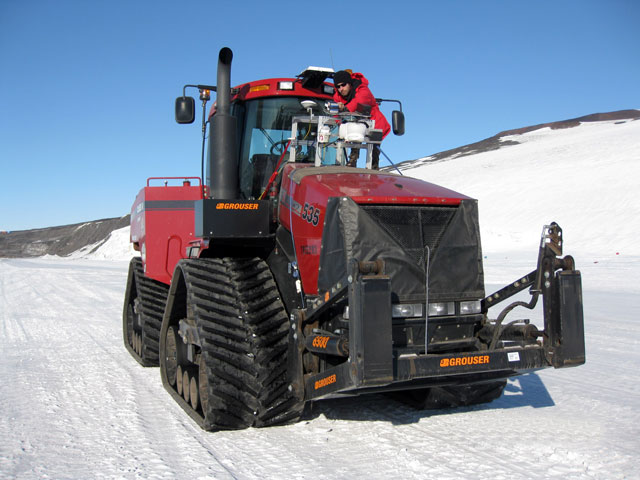|
Keep on truckin'South Pole Traverse adds second train, tests robotic tractorsPosted May 4, 2012
Ten years ago, the idea to drive across more than 1,000 miles of Antarctic wilderness between McMurdo and South Pole Now, Traverse Operations has two traverse platforms, South Pole Traverse 1 and 2 (SPoT1 and SPoT2), each making a round trip every austral summer between the U.S. Antarctic Program “It’s lead-follow technology, basically ready to deploy,” said Paul Thur, Traverse Operations manager, of the technology that will allow the tractor train to run potentially as much as 19 hours a day. “By running two shifts, you would almost halve the time to South Pole,” noted Jim Lever, a mechanical engineer with the U.S. Army Cold Regions Research and Engineering Laboratory (CRREL) 
Photo Credit: Jim Lever
Researcher Dom Jonak from Carnegie Mellon University prepares a suite of robotic sensors for a test run along the South Pole Traverse route to the McMurdo shear zone in February 2011.
“It could be a big payoff,” he added. Currently, it takes about 58 days to get to the South Pole and back from McMurdo. Thur estimates that would drop down to about 38 days once the autonomous system is implemented. “It’s not as easy as running two shifts all the way to the Pole,” Thur explained. For example, the SPoT train would need to switch to all manual control for the crawl up the Leverett Glacier through the Transantarctic Mountains to the polar plateau, meaning the night shift would have to switch temporarily back to days. Thur said that the technology would be tested and integrated with the vehicle operations over the next two field seasons. It’s a bit of reality meets science fiction: In Kim Stanley Robinson’s futuristic novel, Antarctica, he wrote 15 years ago about a very similar robotic traverse manned by a single person. “We’re pretty close,” said Thur, though, in the real world, the traverse would still require a full crew, as half of the eight Case and Caterpillar tractors need a driver, working in two shifts. And drivers would still be needed to operate a tracked vehicle called a Pisten Bully, which leads the front of the train and carries ground-penetrating radar (GPR) on a long boom to detect crevasses near the surface of the ice. But even that task could one day become more automated. A PhD engineering student at Dartmouth College “It would be awesome, because what I would think is nothing [on the screen], somebody else might want to check it out. It’s very subjective,” Thur said. “We’re by no means experts. There are people who do this radar stuff for a living, who have PhDs in radar analysis and things like that.”1 2 Next |



For USAP Participants |
For The Public |
For Researchers and EducatorsContact UsU.S. National Science FoundationOffice of Polar Programs Geosciences Directorate 2415 Eisenhower Avenue, Suite W7100 Alexandria, VA 22314 Sign up for the NSF Office of Polar Programs newsletter and events. Feedback Form |


